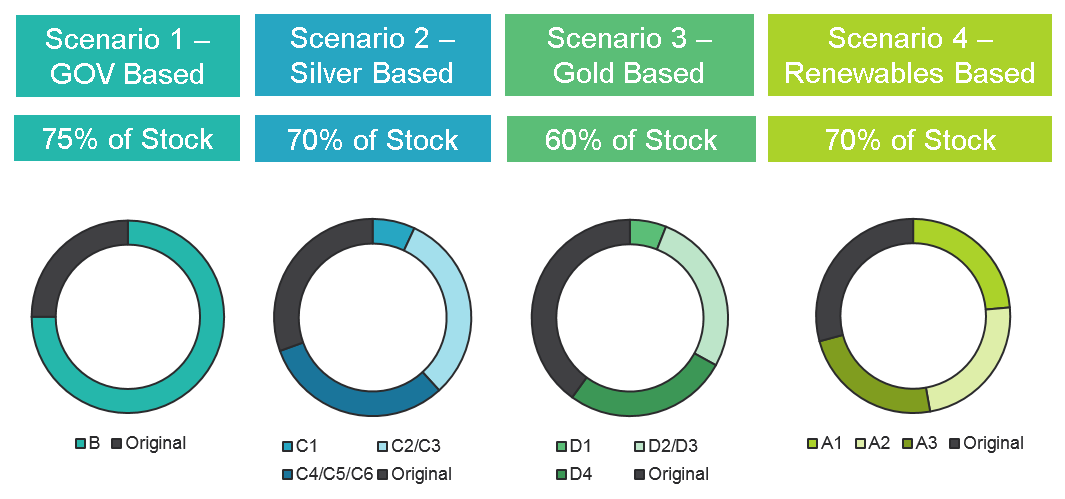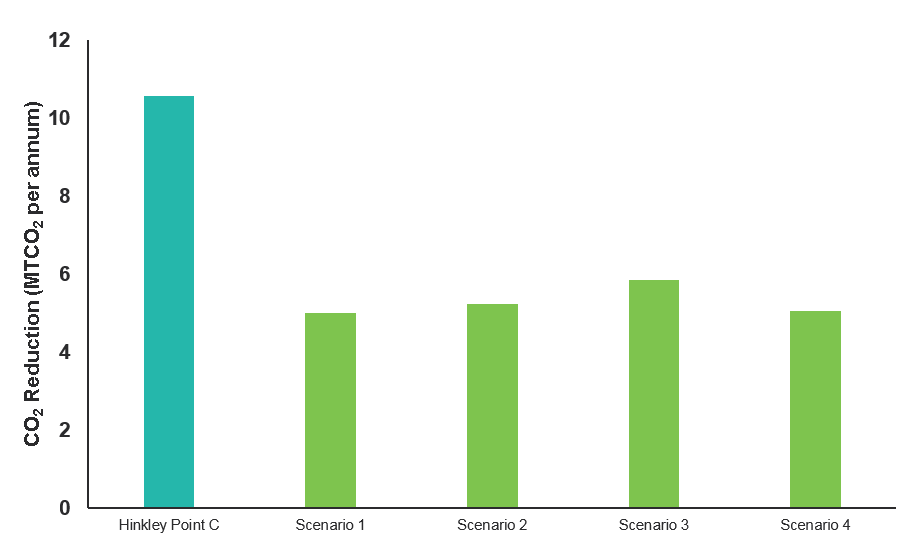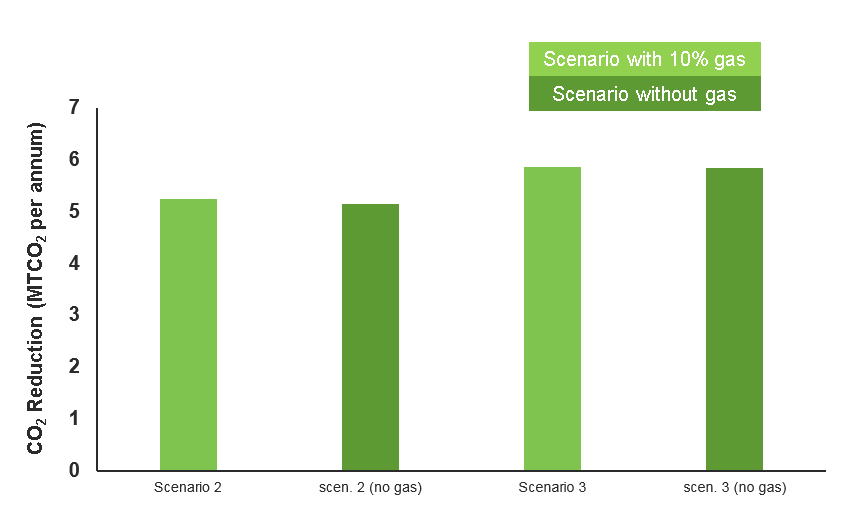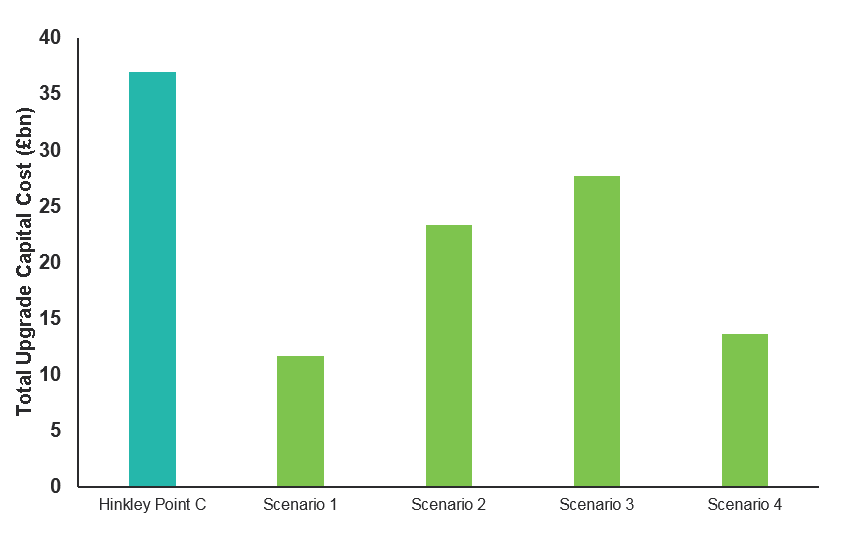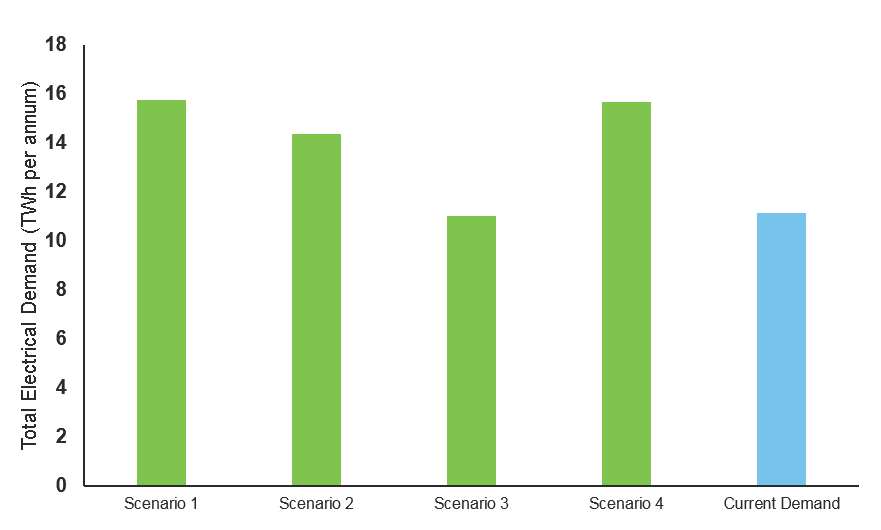Nuclear Generation Scenario
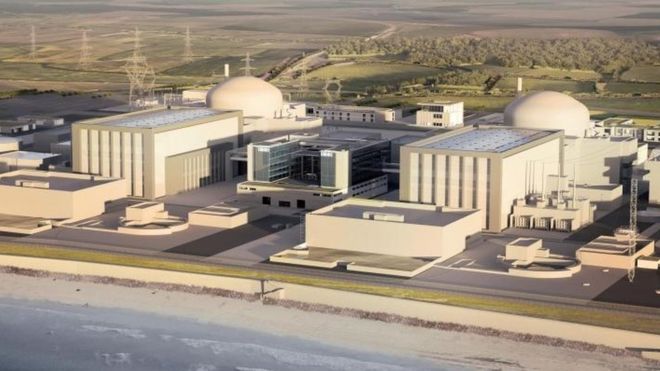 Render of Hinkley Point C
Render of Hinkley Point C
To demonstrate the potential that this modelling has, it is useful to generate a number of retrofit scenarios which can then be compared to another energy system.
As an example here, let's compare retrofit to a nuclear power plant, specifically Hinkley Point C. This power plant based in Somerset is due to be operational in 2025 and will be the first nuclear power plant built in the UK for 30 years. It has been deemed to be an essential part of the UK's future low carbon electricity grid.
The company who will construct and operate the plant, EDF, say that the power plant will produce 25 TWh of electricity per year once in operation. Based on the carbon intensity of electricity as used in HEM (0.422 kgCO2/kWh) this gives a carbon saving equal to 10.55 million tonnes of CO2 saving per year. In terms of costs, there are a range of figures which have been generated from different sources. For this a recent UK study was used, which found that the costs of the construction could be £37 billion. This same organisation suggested just one year earlier that the development would cost £14 billion. This highlights the uncertainty in the final costs.
Using this data, the next step was to create a number of retrofit scenarios. For all of the following scenarios, the total annual energy saved is equal to 25 TWh (the same amount of energy which the power plant produces in a year). Following this approach will allow a direct comparison of the low carbon generation of the power plant to the demand reduction through retrofit. Four retrofit scenarios were generated, based around each of the retrofit categories: government; silver; gold and no fabric improvement. Details of the scenarios to achieve the target energy saving are tabulated below:
As an example here, let's compare retrofit to a nuclear power plant, specifically Hinkley Point C. This power plant based in Somerset is due to be operational in 2025 and will be the first nuclear power plant built in the UK for 30 years. It has been deemed to be an essential part of the UK's future low carbon electricity grid.
The company who will construct and operate the plant, EDF, say that the power plant will produce 25 TWh of electricity per year once in operation. Based on the carbon intensity of electricity as used in HEM (0.422 kgCO2/kWh) this gives a carbon saving equal to 10.55 million tonnes of CO2 saving per year. In terms of costs, there are a range of figures which have been generated from different sources. For this a recent UK study was used, which found that the costs of the construction could be £37 billion. This same organisation suggested just one year earlier that the development would cost £14 billion. This highlights the uncertainty in the final costs.
Using this data, the next step was to create a number of retrofit scenarios. For all of the following scenarios, the total annual energy saved is equal to 25 TWh (the same amount of energy which the power plant produces in a year). Following this approach will allow a direct comparison of the low carbon generation of the power plant to the demand reduction through retrofit. Four retrofit scenarios were generated, based around each of the retrofit categories: government; silver; gold and no fabric improvement. Details of the scenarios to achieve the target energy saving are tabulated below:
Value |
Scenario 1 - Gov |
Scenario 2 - Silver |
Scenario 3 - Gold |
Scenario 4 - no fabric improvement |
Total % of Scottish housing stock retrofitted |
75 |
69.5 |
60 |
70.8 |
Government |
75 |
|||
Silver with Gas (C1) |
6.95 |
|||
Silver with HP (C2 & C3) |
31.3 |
|||
Silver with renewables (C4-C6) |
31.3 |
|||
Gold with Gas (D1) |
6 |
|||
Gold with HP (D2 & D3) |
27 |
|||
Gold with Renewables (D4) |
27 |
|||
No-Fabric Improvement (A1-A3) |
70.8 |
These percentages are displayed in the charts below:
Any mix of retrofit levels could be generated. This is displayed well as part of the tool available in this website. For these four scenarios it was decided that they should each be based around one of the retrofit categories. For all of these retrofit scenarios, the energy demand reduction is equal to the energy generated by the powerplant over a year. The first result to compare is the CO2 emissions reduction, shown in the graph below:
Here the nuclear plant can be seen to have the biggest impact. One point worth noting is that since the majority of these retrofit here have electrification of heat, further decarbonisation of the electricity grid will result in greater co2 savings of the retrofit scenarios. With low carbon generation sources such as wind, hydro and indeed nuclear, the carbon intensity of the electricity could fall dramatically from the 0.422 kgCO2/kwh specified in HEM.
For the silver and gold scenarios, 10% of the retrofitted buildings are fuelled by gas. This was to take into account that gas will still play a part in the future energy grid. Only 10% was used, since the use of gas can have a significant impact on the energy demands of individual buildings. Scenarios were generated for scenarios 2 and 3 without the use of gas, but the differences are relatively small as shown the graph below:
For the silver and gold scenarios, 10% of the retrofitted buildings are fuelled by gas. This was to take into account that gas will still play a part in the future energy grid. Only 10% was used, since the use of gas can have a significant impact on the energy demands of individual buildings. Scenarios were generated for scenarios 2 and 3 without the use of gas, but the differences are relatively small as shown the graph below:
The next results to look at here are the costs. As mentioned in the results section, the costs used in this project are based on the built-in HEM data, which represents large scale deployment. The cost results for these scenarios is shown here:
At £37 billion, the cost of Hinkley is significantly larger than all of the retrofit options. The shallow retrofit scenarios 1 and 4 are 65% cheaper compared to the nuclear plant and the deep retrofit option of scenario 3 is 25% cheaper. This highlights that retrofit can be cost effective on a large scale where economies of scale can drive down costs.
These results show that the same energy savings can be achieved through the shallow retrofit options, at a significantly reduced cost. This is down to the effectiveness of the heat pumps which are low cost compared to a deep retrofit. However, this electrification of a huge percentage of the heating demand will cause significant stresses on the electricity grid, particularly in terms of balancing supply with demand. The image below shows the variation in demand of electricity and gas. Since the majority of heating is currently supplied by gas, the seasonal and daily swings are sizable, with the winter gas demand being around 6 times that of the summer gas demand. Even with the improved efficiency of heat pumps, this variation in demand will provide a massive hurdle for large scale low carbon heat. Solutions that are currently being developed to tackle this include storage and renewable gas, however how does the use of large scale deep retrofit affect the results?
These results show that the same energy savings can be achieved through the shallow retrofit options, at a significantly reduced cost. This is down to the effectiveness of the heat pumps which are low cost compared to a deep retrofit. However, this electrification of a huge percentage of the heating demand will cause significant stresses on the electricity grid, particularly in terms of balancing supply with demand. The image below shows the variation in demand of electricity and gas. Since the majority of heating is currently supplied by gas, the seasonal and daily swings are sizable, with the winter gas demand being around 6 times that of the summer gas demand. Even with the improved efficiency of heat pumps, this variation in demand will provide a massive hurdle for large scale low carbon heat. Solutions that are currently being developed to tackle this include storage and renewable gas, however how does the use of large scale deep retrofit affect the results?
The graph below shows the annual electricity demand for the four retrofit scenarios. Highlighted on the right is the current electricity demand according to this modelling.
All four scenarios have a significant proportion of the heating demand supplied by electricity, through the use of HPs as follows:
The graph shows scenario 1 and 4, with little or no fabric improvements, the annual electricity demand increases by 40%. Comparing this to Scenario 3, which uses very deep retrofit measures in combination with heat pumps, there is no increase in electricity demand, and in fact from our modelling, there is a slight decrease in electrical demand.
Although this seems obscure, the SHCS states that approximately 11% of heating is supplied by electricity, mostly through instantaneous heaters or storage heaters. This modelling shows that with the use of the deep retrofit gold standard, 54% of Scottish housing can be fed with electrified heat, with no more electricity demand from heating that is currently experienced.
Electrification of heat can allow for the provision of low or zero carbon homes and the use of deep retrofit could negate some of the challenges which will be faced. While scenario 1 and 4 will require significant investment in technologies such as storage, this could be invested in deep retrofits to achieve a more stable grid.
This could strengthen the business case for deep retrofit when looking at large scale implementation and the modelling in this project could inform further research in this area in the future.
- Scenario 1 (Gov) - 75%
- Scenario 2 (Silver) - 63%
- Scenario 3 (Gold) - 54%
- Scenario 4 (no fabric improvement) - 71%
The graph shows scenario 1 and 4, with little or no fabric improvements, the annual electricity demand increases by 40%. Comparing this to Scenario 3, which uses very deep retrofit measures in combination with heat pumps, there is no increase in electricity demand, and in fact from our modelling, there is a slight decrease in electrical demand.
Although this seems obscure, the SHCS states that approximately 11% of heating is supplied by electricity, mostly through instantaneous heaters or storage heaters. This modelling shows that with the use of the deep retrofit gold standard, 54% of Scottish housing can be fed with electrified heat, with no more electricity demand from heating that is currently experienced.
Electrification of heat can allow for the provision of low or zero carbon homes and the use of deep retrofit could negate some of the challenges which will be faced. While scenario 1 and 4 will require significant investment in technologies such as storage, this could be invested in deep retrofits to achieve a more stable grid.
This could strengthen the business case for deep retrofit when looking at large scale implementation and the modelling in this project could inform further research in this area in the future.
